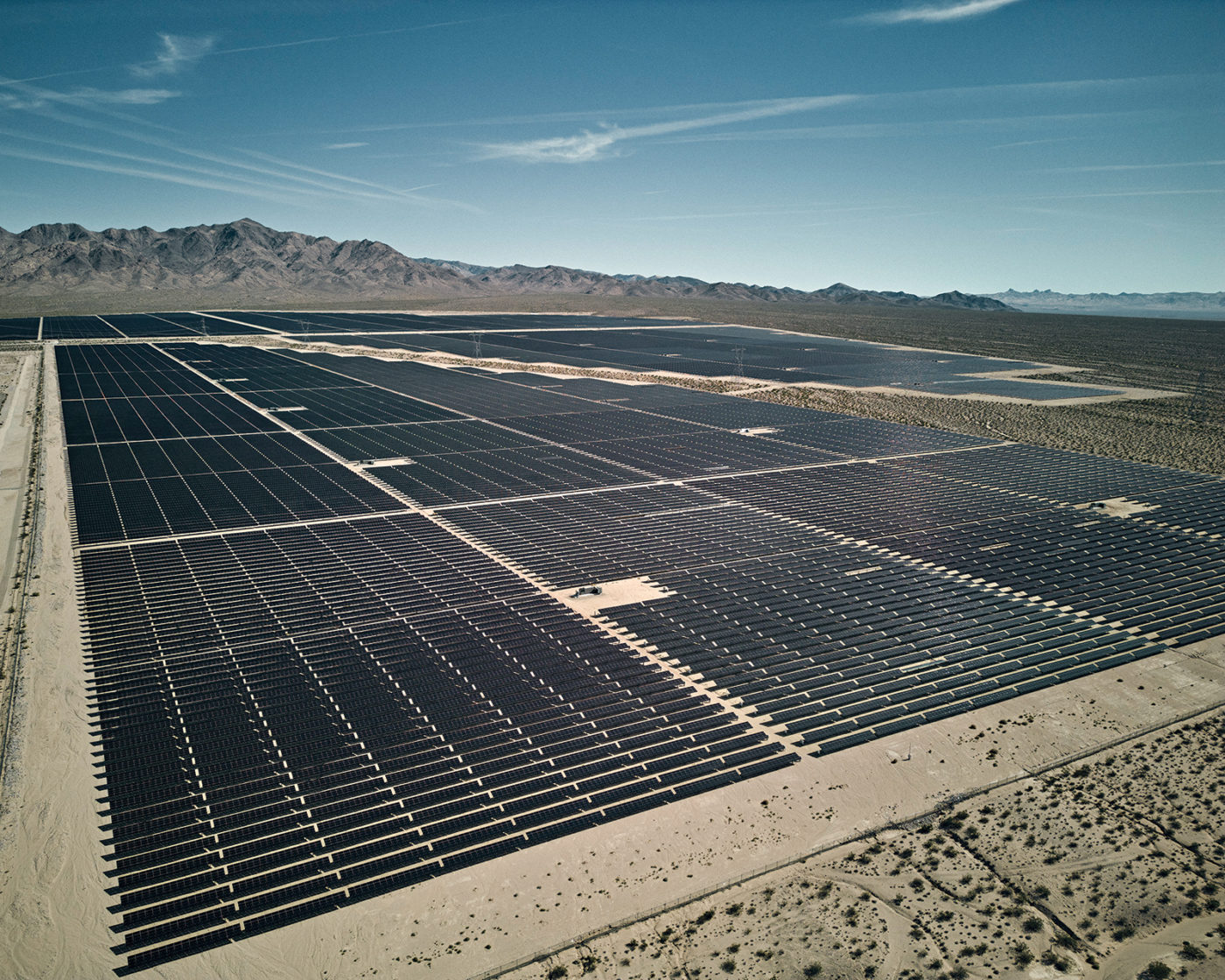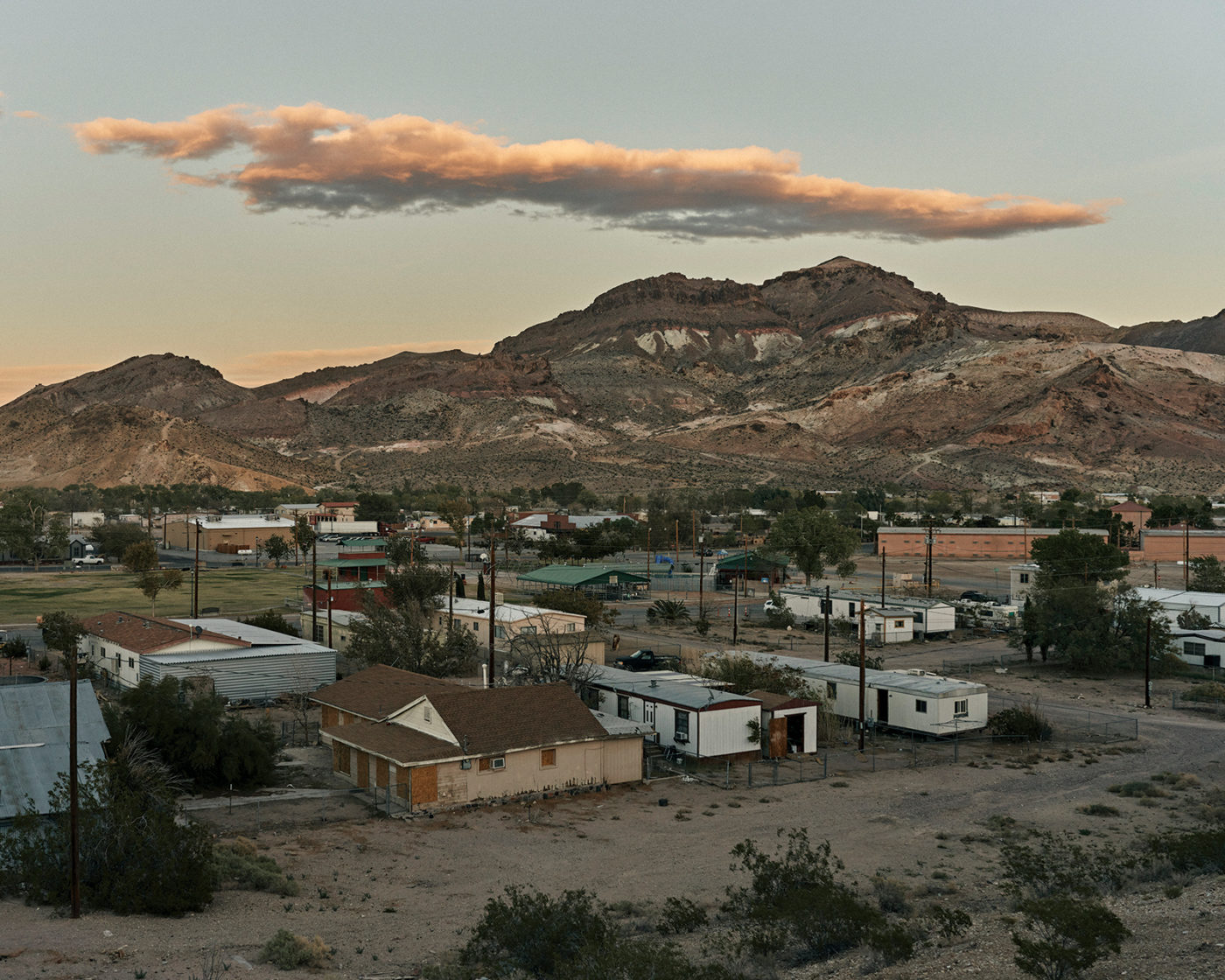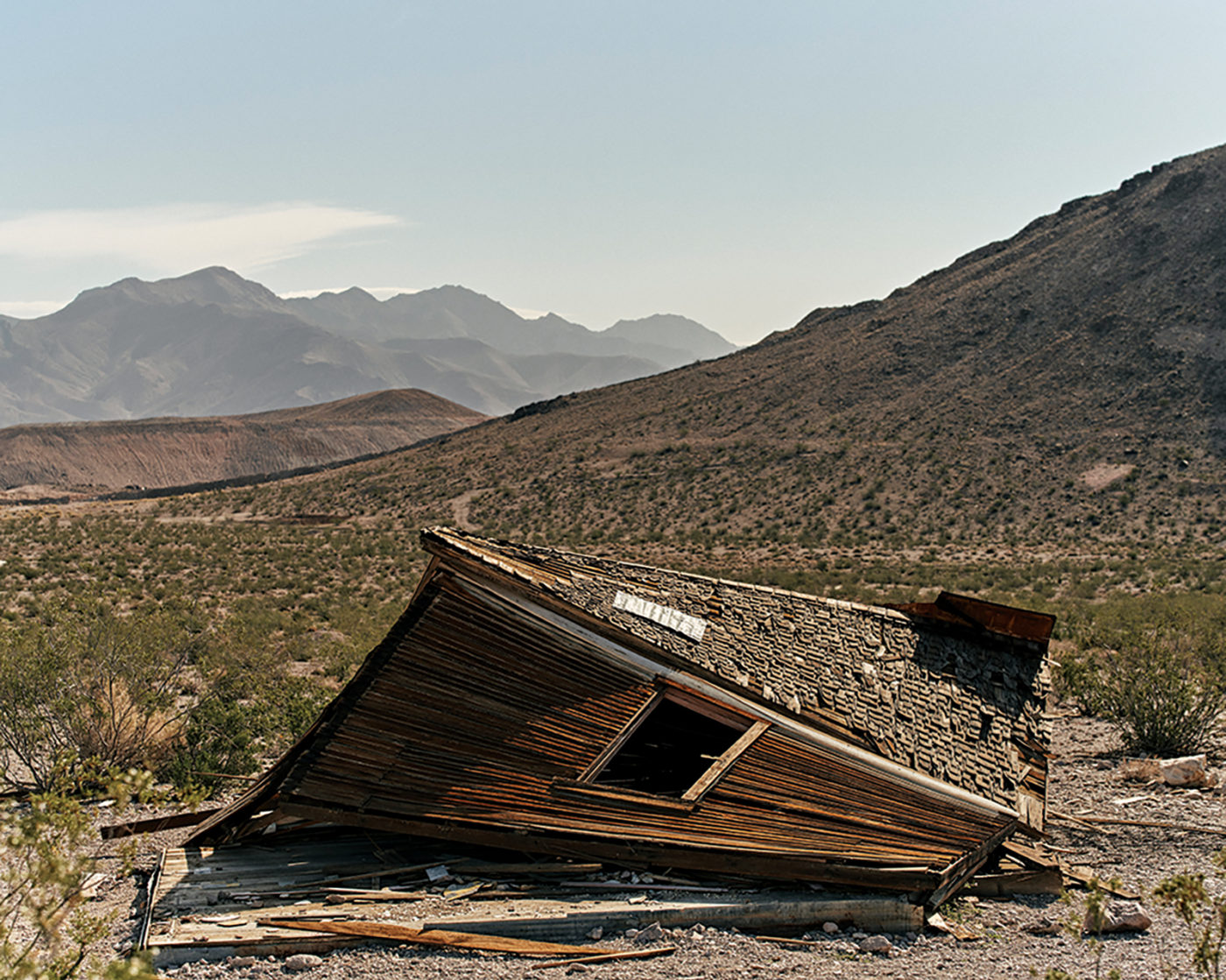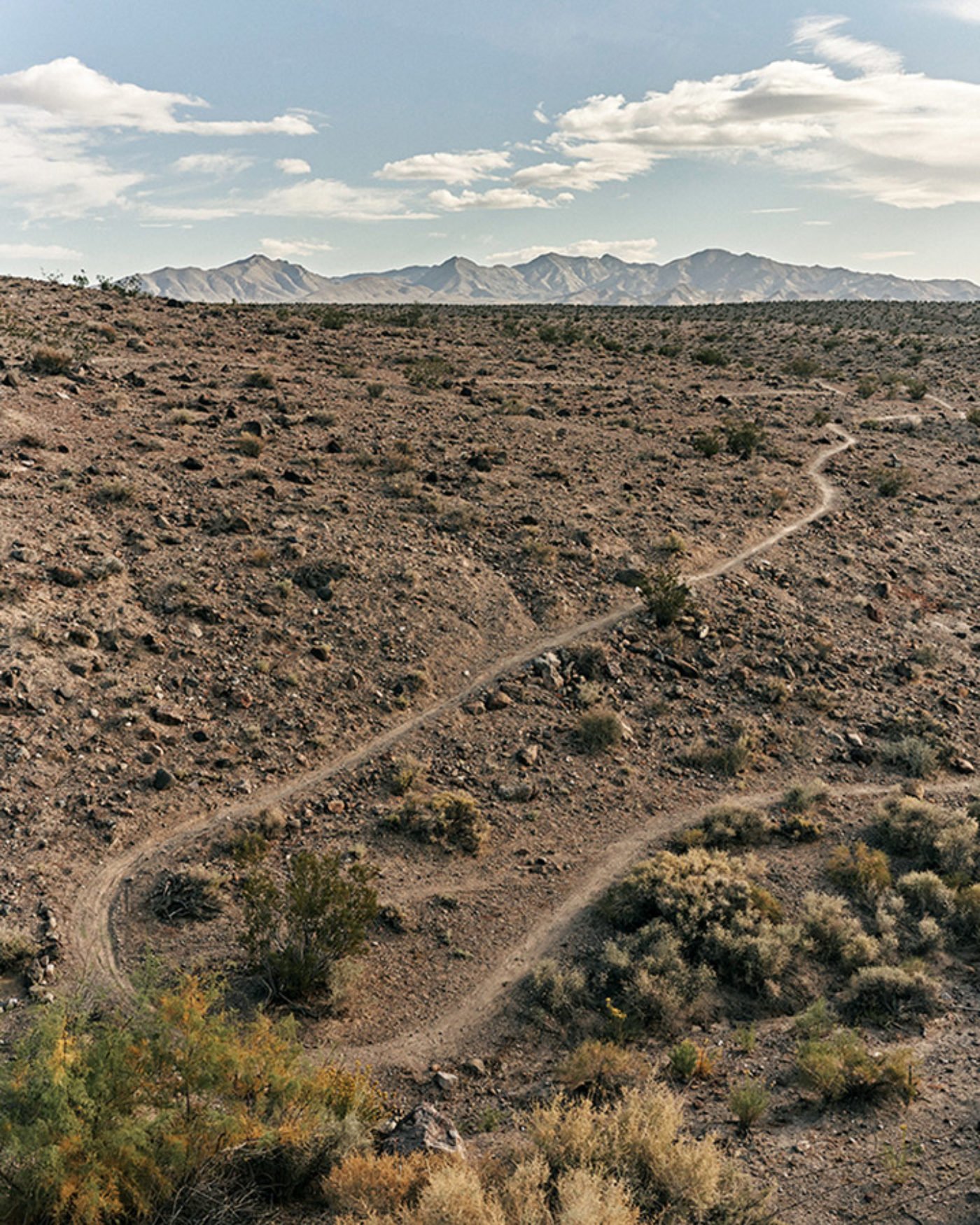I n a 1947 article for this magazine, the essayist and historian Bernard DeVoto warned of the “forever-recurrent lust to liquidate the West.” “Almost invariably the first phase was a ‘rush,’ ” he wrote. “Those who participated were practically all Easterners whose sole desire was to wash out of Western soil as much wealth as they could and take it home.” For DeVoto, the New Deal offered a chance for more sustainable and locally beneficial uses of Western resources, but, in the end, Eastern capital was “able to direct much of this development in the old pattern.”
When outsiders try to describe the solar rush, they reach for historical analogies: the 1889 Oklahoma land rush; the early-twentieth-century eucalyptus boom that tore up the desert; housing speculation and development in the Aughts. But in Beatty such boom-and-bust cycles—the sort they’ve been trying to break out of for the past ten years—are part of the everyday landscape. In the desert, the past is close to the surface. There’s not much soil to bury things. Footprints and petroglyphs, railroad grades and telegraph lines, mine shafts and tin cans, whiskey and beer bottles—all of it just sits there in the sun, alternately baking and freezing. This makes it easy to situate the solar rush in the long history of government-facilitated expropriation of and extraction from public land.
The first act of plunder, of course, involved the wrenching dislocations of Native peoples of which the very idea of “public land” is a residue. This valley is part of the ancestral territory of the Timbisha Shoshone, today a federally recognized tribe that resides on some 7,500 acres of reservation land, three hundred of which are located inside Death Valley National Park. In addition to public meetings such as the one with NextEra, representatives of the tribe have separate, government-to-government consultations with the BLM. When I spoke to Barbara Durham, the tribal historic preservation officer, she made it clear that the Timbisha Shoshone support Beatty’s resistance to solar projects in the region. The tribe has concerns about how the farms might affect cultural resources, as well as water and wildlife, even though the sites fall outside official reservation boundaries.
The second act of plunder was the gold rush. Mining for silver and gold began in the Bullfrog district in 1904 and continued through 1920. This produced the boomtown of Rhyolite, which at its peak boasted concrete sidewalks, an opera house, and a population of ten thousand. As the region was blanketed in mining claims, Beatty grew as a transportation and supply center, equipping nearby towns and mining camps. But in less than twenty years the newspapers folded, the railroads stopped running, the electricity was shut off, and the people disappeared. The train tracks and railroad ties were torn up for scrap metal and wood. Of all the regional settlements, Beatty was the only one to survive.
Then came the Cold War transformation of much of the region into what the historian Valerie Kuletz has described as “the most bombed place on earth, the most fully realized sacrifice zone in the United States.” Between 1951 and 1992, almost a thousand nuclear tests were conducted at the Nevada Test Site, only twenty miles from Beatty. Old-timers remember seeing the glowing mushroom clouds as children. The town was spared the worst of the effects— so-called downwinders east of the site suffer cancers and birth defects from radiation. But nuclear tests polluted an estimated 1.6 trillion gallons of groundwater long before the West’s current drought. Beatty is in no immediate danger, but Kevin and Laura’s groundwater is tested every year for radioactive residue, just in case.
And most recently, there was the modern mining boom, which in Beatty began in the early Eighties and lasted about fifteen years. In addition to providing jobs, the old Barrick Gold mine invested in the town. An employee at the local museum recalled the mine making donations to help start the museum, contributing to local civic organizations, and supporting the schools. They fixed the roof on the train depot and built a playground. The epilogue of one of Barrick’s annual reports from the mid-Nineties states optimistically that “the new Bullfrog Mine was built to withstand the natural and economic storms which brought the District’s first mining era to a close.” But the price of gold and silver dropped shortly thereafter, and the mine closed in 1996. Beatty’s population dropped from more than one thousand to around eight hundred. The butcher and the grocery store went out of business. Drug use rose. School enrollment halved, dropping from three hundred to one hundred and fifty. “Barrick wasn’t the first,” Erika told me. “We’d been through this cycle before. We knew what would happen when they left.”
Beatty made its pivot to tourism soon after. At first, the transition was, in Erika’s words, “a subtle shift,” one that capitalized on the town’s proximity to Death Valley National Park. Now Beatty boasts numerous restaurants, hotels, and campgrounds, as well as growing networks of OHV and mountain bike trails. Beatty still has a ways to go before it becomes “the next Moab,” an arguably questionable aspiration I heard several residents voice. And the revival of gold mining in the area—which Beatty has welcomed, even though it’s more destructive than solar—may still undermine these plans. But the idea that tourism can get Beatty out of the boom-and-bust cycle through what David Spicer describes as a “demonstration of the long-term, thriving use of public lands” has been persuasive to residents, who have benefited from the additional jobs and income.
Before the town hall meeting, one NextEra employee had told me the people of Beatty were “different.” They had “an extractive history,” he said. “They understand that some use is necessary.” But to me, their relationship to the land seemed more complicated. While DeVoto believed that Westerners were complicit in their land’s “rape” by Eastern interests, Beatty’s embrace of tourism suggested a break from these old patterns. Everyone emphasized what a big shift the gateway to death valley sign represented, marking the transformation of a mining town that might have ignored or disparaged the national park on its doorstep into one that actively courts its visitors. Tourism represents a more sustainable future for the town and its land, one more in line with progressive commitments to deep change. As one resident told me, “Solar is like mines. They think in fifteen-to-twenty-year cycles. They plan on a finite timeline. But people’s desire to get out and commune with nature is transcendent. It’s a better long-term investment.” And avoiding short-term abuses is exactly what residents are trying to do when they protest solar today.
One example of what they fear is only an hour up U.S. Route 95: the Crescent Dunes Solar Thermal Power Plant.* Dogged by mechanical problems since its opening in 2015, the developer declared bankruptcy in 2020. When I saw it a year later, it looked like the abandoned remains of an alien civilization. The 640-foot central power tower stood quiet; the mirrored panels were dimmed by dust and blankly faced the sky. It is now operating again at a reduced capacity, but the technology is largely obsolete.
Some of Beatty’s objections are easily dismissed as NIMBYism. But the town’s resistance also raises a profound question: In a world replete with wasted landscapes, why steer solar toward remote and undeveloped territory? So-called disturbed lands—unreclaimed brownfields, defunct mining sites, and fallowed agricultural fields, or even canals, parking lots, and highway medians—are all places where solar panels, substations, and transmission lines could be built. But the sheer existence of cheap and plentiful public land facilitates the construction of a new energy system in the old model—in which the federal government lowers barriers to private development, centralized energy generation, and long-distance transmission.
The use of public land to encourage expansion and investment in the private sector is a well-worn strategy in the United States. To help railroads cross the continent in the nineteenth century, the federal government provided companies with millions of acres and assistance securing rights-of-way. To promote renewable energy development today, it offers cheap leases for public lands and tax credits to make investments less risky. This means that investor-owned utilities and solar companies have little incentive to build on private property, which is more expensive, requires time-consuming negotiations with owners, and can often be acquired only in small parcels. Conservationists argue that the easy availability of public land has caused a creep toward ever-larger projects and diminished our imagination for solar’s versatility.
To some critics, the BLM is part of the problem. The agency, which is often derisively referred to as the Bureau of Logging and Mining, isn’t the kind of forward-thinking public agency you’d imagine driving the energy transition. Despite new, progressive political appointments at the top, district-level agency culture skews conservative, and has long been more responsive to industry needs and local political pressure than to conservation efforts or the public trust. The agency is still recovering from the chaos of the Trump Administration, during which its headquarters moved to Grand Junction, Colorado, and the bureau saw a wave of retirements and a huge loss of knowledge and expertise. The remaining staff members are ill-equipped to handle the volume of filings they receive. Agency efforts to push developers toward locations less likely to generate controversy have largely failed. While the BLM responded to complaints from Beatty residents by assigning the most offensive of the proposed sites “low priority” status, developers are still setting the agenda.
The BLM’s existing legal and bureaucratic structures aren’t well-suited to the comprehensive thinking that designing a new energy system would require. The agency’s approval process is determined by the National Environmental Policy Act (NEPA), a law that is over fifty years old and which requires federal agencies to carry out environmental reviews. NEPA is often criticized by developers as red tape. But for advocates of smarter land-use planning, the problem is that the permitting process is designed to evaluate individual projects rather than to examine the effects of routing transmission lines, siting substations, and developing solar farms in the aggregate. This also means that opponents of solar energy, such as those in Beatty, can only publicly comment on projects one at a time. Lawsuits must be filed the same way, in a losing game of whack-a-mole.
Acutely aware of these problems, advocates have proposed a variety of ways to avoid energy sprawl and to “spare the land,” in the words of Dustin Mulvaney, a solar expert and professor at San José State University. Zichella, the retired energy transmission expert, outlined the ideal scenario for the country’s transition to renewables: orderly construction along designated transmission corridors, the use of both rooftop and utility-scale sources, and the prioritization of disturbed lands. But in reality, activists and policymakers have had to work hard to steer energy production away from developers’ bottom lines. One instructive example can be found in southern California. Local protests there resulted in the 2016 Desert Renewable Energy Conservation Plan. While far from perfect—especially in the eyes of people like Kevin and Laura—the plan conserved portions of the desert and effectively zoned others for renewable energy development. Other local and national efforts have tried to guide development toward disturbed lands. The EPA’s RE-Powering America’s Land Initiative has created a database of contaminated lands that could be used for renewable energy, and the Nature Conservancy’s Mining the Sun Initiative encourages solar on former mine lands, offering an economic alternative to prison construction in old fossil-fuel-producing regions, such as the mountains of Appalachia.
But for now, Beatty’s public lands remain the Wild West. Multiple solar developers are filing applications at the same time, sometimes on top of one another, as they bet on future routes of transmission lines, while mining companies, lithium speculators, and geothermal developers all eye the same areas. This is happening without any real discussion and very little planning. During the New Deal, a federal agency was created to help manage and direct these kinds of large-scale changes in infrastructure and land use. Today, the BLM doesn’t have the resources to play that role. Current efforts to streamline NEPA and energy permitting processes accelerate these dynamics without addressing the fact that no deliberate decisions are being made about the use of public land, what kind of future we want, or what kind of system we’re building. As Patrick Donnelly of the Center for Biological Diversity told me, “there’s no one in the driver’s seat.”

O n a sunny Saturday last February, Laura and Kevin drove me out to Sarcobatus Flat, another mind-boggingly vast and remote valley twenty miles north of Beatty. Sarcobatus Flat is located along the proposed route of Greenlink West, one leg of a new statewide triangle of transmission lines. The valley is also being prospected for lithium, a crucial element in electric-car batteries. To reach it, we crossed the headwaters of the Amargosa River, which runs south, often underground, into California. The Amargosa makes Beatty a rare riparian corridor in the desert, containing springs, wetlands, and the highest concentration of endemic species in the United States, such as the critically endangered Devils Hole pupfish, and the Amargosa toad, which Spicer and others in Beatty have been working to protect. Kevin and Laura told me about a pronghorn fawning ground they found nearby. After more than a century of absence, the antelopes had returned, perhaps as a result of the wildflower blooms that have followed recent summer storms. They described how the alkali surface of the playas—dried, prehistoric lake beds—flood when it rains, and shine under the full moon.
For their defense of these places, activists like Laura, Kevin, Karl, and Erika are dismissed not only by solar developers or utility companies, but by climate justice movements and large environmental organizations, which, in Laura’s words, “don’t want to be painted as being against climate change or critical of renewable energy.” She describes being ostracized and silenced at Sierra Club meetings and struggling to find lawyers willing to take on antisolar lawsuits. I don’t find this hard to imagine. We need renewable energy and we need it now. We need large-scale projects as well as small ones. We need wind and geothermal and (probably) nuclear. Even many desert activists now agree that we need renewables wherever we can get them, as fast as possible. And solar is far from the worst ongoing use of public land—oil and gas leasing, alfalfa growing, and ranching are all more harmful. But to dismiss Beatty’s protest is to ignore some key questions: How can we do things more responsibly this time around? Must we accept the old ways as the only path forward?
After we’d had our fill of lithium claims, we drove over to see the spectral remains of Rhyolite, the former boomtown. Today, it is once again thriving. When we arrived, it was hopping with tourists on their way to or from Death Valley. The grand old Spanish-style train station, normally locked up behind a gate and barbed-wire fence, was open to visitors. Kevin, Laura, and I stood in the shade of the crumbling wraparound porch, talking about possible futures. It was easy to picture the next extractive cycle: construction noise interrupting the astral silence of the daytime, security lights shattering the night’s dark skies, the valley flooded with lakes of shining solar panels. But with all the visitors milling about, it was just as easy to imagine Beatty’s tourist economy flourishing, wasted coal and agricultural communities revived through investment in renewables, and public land managed with a new ethos of sustainability and civic trust.
It felt ironic, contemplating the future while ghosts of the past lurked all around us. Kevin, Laura, and I looked out at the ruins of the old bank building, once three stories tall. Comparisons to ancient Rome were tempting: bleached stone, the folly of greed and power, the impermanence of it all. And as if the buildings didn’t do enough to bring the past to life, in 1984 the Polish-Belgian artist Albert Szukalski had re-created The Last Supper here by draping live models in wet sheets covered in plaster and letting them harden in the desert sun. For over thirty years now, these plaster ghosts have loomed over the valley—facing the very sites threatened by development.
I considered the challenges of doing things differently. How solar development on public land is fettered by a legal and bureaucratic infrastructure ill-suited for large-scale planning. How the power of utilities and energy developers is no match for a gutted public agency asked to handle massively consequential decisions. And how public understanding is hampered by the creation of a false dichotomy between ecosystems and renewable energy development that pits environmental protections against social and economic justice.
In Beatty, hopes for the future are tempered by visible lessons from the past. If we can’t find a way to listen to them, it’s not hard to imagine these plaster figures a few decades from now, overlooking a new ghost town as the solar panels below gather dust and eventually crack, decay, and blow away.



